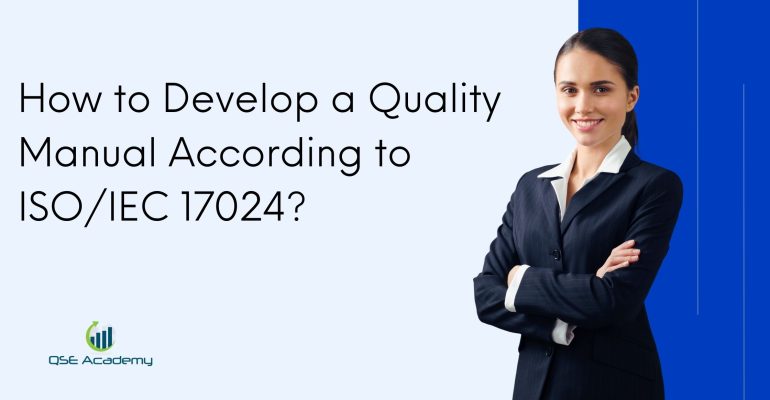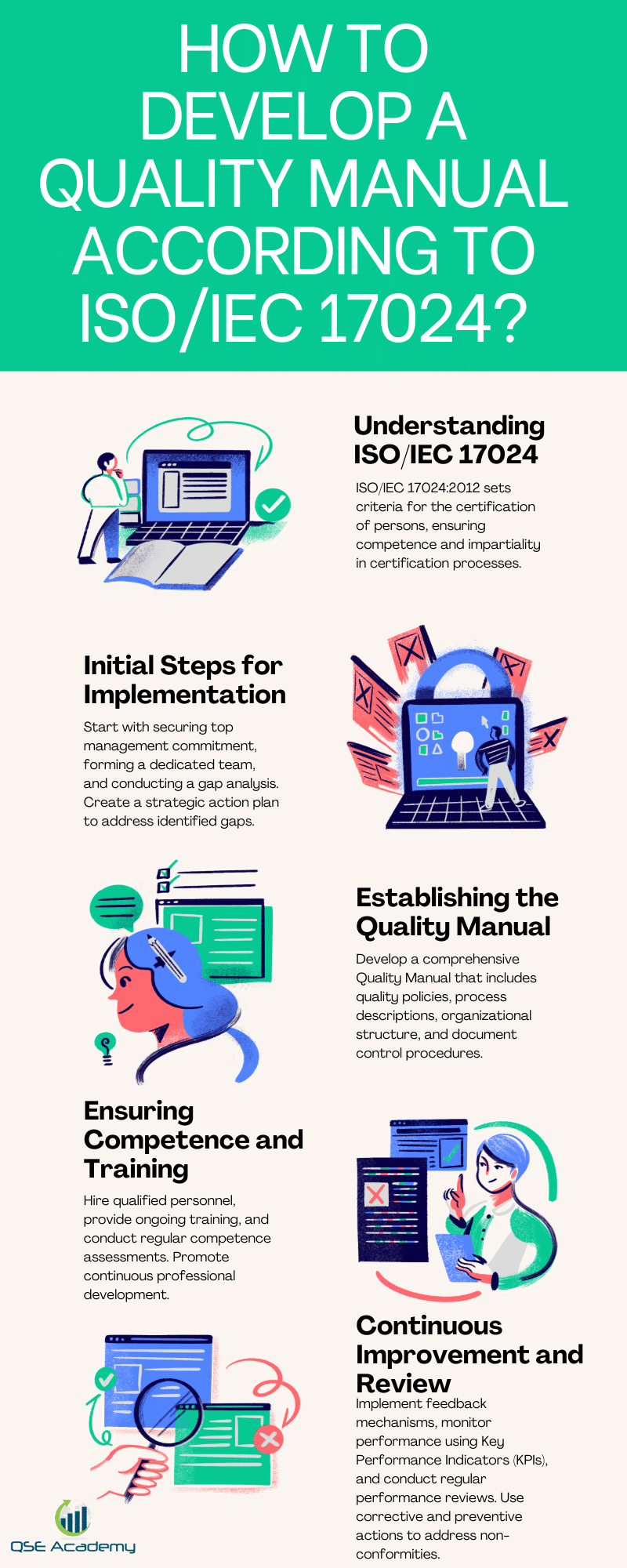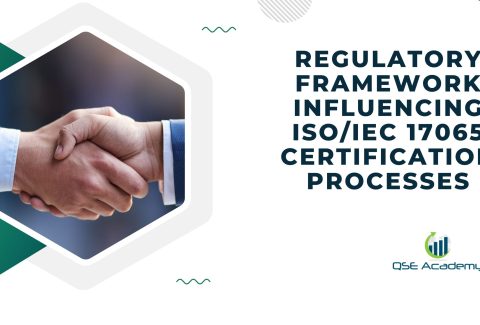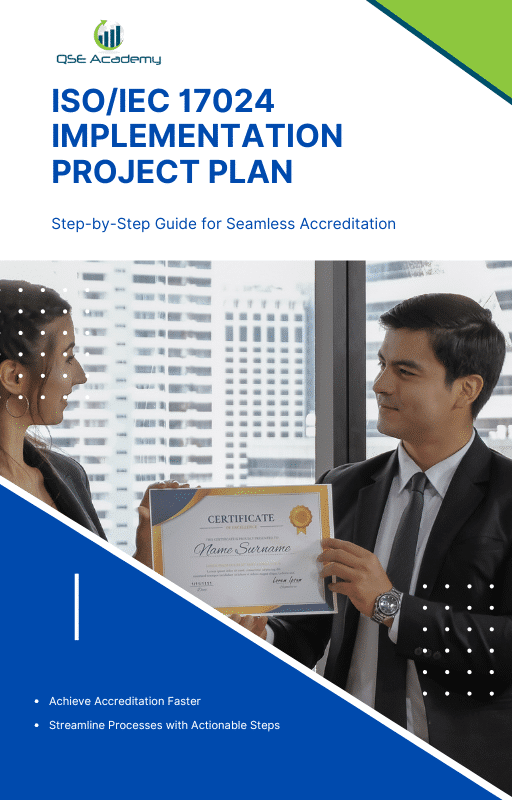How to Develop a Quality Manual According to ISO/IEC 17024?
Imagine a world where the certification of persons is as credible and consistent as a Swiss watch. ISO/IEC 17024:2012 provides that level of precision for certifying bodies aiming for excellence. This international standard sets the bar for a quality management system, ensuring competent and fair processes.
For those unfamiliar, ISO/IEC 17024 is the benchmark for organizations certifying individuals in various professions and trades. It outlines the need for a systematic approach to managing certification schemes, demanding the creation of a comprehensive Quality Manual. Crafting such a manual is not just a requirement but a strategic tool for demonstrating the integrity and reliability of your certification process.
Intrigued by the complexity and importance of this document, our article embarks on a detailed expedition through the landscape of ISO/IEC 17024. From understanding its core principles to the final touches of best practices, we navigate the terrain of creating a robust Quality Manual, ensuring your certification body stands tall and unshaken in a world that values trust and excellence. Join us as we unfold the blueprint to success in the following sections.
Introduction
ISO/IEC 17024:2012 is a globally recognized standard that sets forth the criteria for the certification of persons. It encompasses various elements essential to carry out the certification process, such as the development and maintenance of a certification scheme, the assessment of individuals, and the management of impartiality throughout the certification process. At the core of organizations seeking accreditation to this standard is a robust Quality Manual.
A well-crafted Quality Manual is vital for certification bodies as it delineates procedures, responsibilities, and management processes that assure the quality and integrity of certifications granted. It serves as a foundational document that supports a consistent approach to personnel certification, ensuring that all processes meet the high rigor of international standards.
The objective of this article is to outline the importance and components of an ISO/IEC 17024 Quality Manual, guiding certification bodies through the effective creation and implementation of this key resource. We will be delving into aspects such as the certification process, internal audit checklists, documentation requirements, and adherence to relevant standards. Our focus will be on clarity and precision, to help stakeholders understand the necessity of a comprehensive manual in supporting quality management within personnel certification programs.
In ensuring a user-friendly experience, expect paragraphs to be concise, and information may be presented in tables or lists where they contribute to a clearer understanding.
Understanding ISO/IEC 17024
ISO/IEC 17024, a well-recognized global standard, plays a pivotal role in the certification of persons, setting the bar for organizations that conduct personnel certification programs. Emerged as a necessary framework for certification bodies, its history and continual evolution reflect an ongoing commitment to uphold the integrity and professionalism in the certification process.
Initially developed by the International Organization for Standardization and the International Electrotechnical Commission, ISO/IEC 17024 has gone through substantial updates, with ISO/IEC 17024:2012 being the most current version. The scope of this standard is expansive, applying to an array of industries and sectors. Organizations that align with its criteria benefit from enhanced credibility, international recognition, and assurance in the competency of certified individuals.
A fundamental tenet of ISO/IEC 17024 is impartiality, ensuring that certification processes are fair, objective, and unbiased. Alongside, it mandates a high level of competence both in the personnel being certified and the bodies providing certification. This dual focus generates trust and consistency, key aspects that are essential for maintaining the robustness and reliability of certifications across diverse professional landscapes.
Knowledgeable in the ISO/IEC 17024 quality manual is crucial for certification bodies aiming at high-quality management and operational excellence. With strict adherence to the standard’s core principles and requirements, bodies that follow ISO/IEC 17024 not only streamline their certification processes but also fortify their reputation among peers, industries, and international bodies.
In summary, understanding ISO/IEC17024 equips certification bodies with the foundation to develop a quality-driven, credible certification scheme, instrumental for building a workforce that meets professional standards of excellence.
Components of a Quality Manual
An ISO/IEC 17024 Quality Manual serves as a comprehensive document that guides certification bodies in implementing a personnel certification program. This manual outlines the system by which organizations operate to meet the rigorous international standards for certifying persons. Since adherence to ISO/IEC 17024 is critical for certification bodies to gain recognition and trust, the Quality Manual is pivotal in establishing a transparent and consistent certification process.
Quality Policy
At the heart of a Quality Manual is the Quality Policy. This statement is a declaration of the certification body’s commitment to maintain the highest levels of quality and adherence to relevant standards, including ISO/IEC17024:2012. When drafting a Quality Policy, it is essential to align with the organization’s strategic objectives, ensure it is appropriate for the Scope of Certification, and underline the commitment to satisfying the applicable statutory and regulatory requirements.
Scope of the Quality Manual
Defining the scope of the Quality Manual means stating what the organization plans to achieve with its certification scheme, and which activities and processes will be governed by the manual. This clarification sets the boundaries and identifies the applicability of the manual across the organization’s functions and services.
Process Descriptions and Procedures
Comprehensive process descriptions and Procedures for personnel certification are essential components. They provide a blueprint for activities like the certification process, audit checklists, and mandatory procedures. For quality management, creating well-defined Standard Operating Procedures (SOPs) ensures consistency and efficiency in the execution of tasks.
Organizational Structure
An unambiguous organizational structure should be documented, highlighting the hierarchy, defining roles, and detailing responsibilities essential for the execution of the certification process.
Documentation and Record Control
Effective control and maintenance of documentation are vital. It establishes a systematic method for creating, reviewing, and updating documents, ensuring they remain current and useful. Records serve as evidence of conformity to the standard and demonstrate the integrity and transparency of the certification processes.
Following these components helps in maintaining a robust foundation for a certification body’s operations, thereby ensuring compliance with ISO/IEC 17024 and fostering trust with accreditation bodies and stakeholders.
Steps to Develop a Quality Manual
Crafting a Quality Manual in line with ISO/IEC 17024 standards is pivotal for certification bodies that conduct personnel certification programs. Here, we outline essential steps for developing an effective Quality Manual.
Step 1: Planning and Preparation Success begins with thorough planning. The initial assessment identifies what is needed, while resource allocation ensures that the right tools and personnel are in place. This builds a strong foundation for a Quality Manual that meets ISO/IEC 17024 standards.
Step 2: Understanding Requirements Knowledge is power. Delving into the clauses of ISO/IEC 17024, it’s critical to map out the standard’s requirements against organizational practices. This ensures every relevant element is addressed in the certification process and in audit checklists.
Step 3: Drafting the Quality Manual Next is structuring and drafting the manual. Clear, concise language forms the basis of an accessible document, dictating procedures for personnel certification and the Scope of Certification, in alignment with the certification scheme.
Step 4: Review and Validation Quality doesn’t exist in a vacuum. Through internal reviews and input from stakeholders, the draft undergoes validation. This collaborative stage polishes the document, ensuring compliance with ISO/IEC 17024 requirements.
Step 5: Implementation A Quality Manual is not a static entity; it’s a living tool that the organization must fully embrace. Implementation involves communicating its contents and providing training to ensure adherence to established practices.
Step 6: Monitoring and Evaluation Finally, a manual is only as good as its results. Ongoing audits, employing assessment organization techniques, and feedback loops create a cycle of continuous improvement, embedding quality into the fabric of the certification body’s culture.
Best Practices and Tips
Creating a comprehensive ISO/IEC 17024 Quality Manual is a critical component for any organization seeking to operate a personnel certification program. Section 4 of the manual is devoted to best practices and tips to ensure your manual not only meets the standard requirements but is also user-friendly and efficient.
Engaging Stakeholders:
To secure buy-in and valuable insights for your Quality Manual, it’s essential to involve stakeholders early in the process. Deploy surveys, conduct focus groups, or hold meetings to gather input. These methods provide diverse perspectives on the quality manual’s usability and effectiveness.
Ensuring Clarity and Accessibility:
Write procedures and policies in simple language to make them easily understandable. Avoid jargon and use formatting tools like bullet points or numbered lists to break down complex information. Use headings and subheadings to organize content, and consider incorporating a table for a clear overview of certification processes or audit checklists.
Maintaining Consistency:
Maintain a uniform style and format across all documents within the certification scheme. Consistency helps users navigate the manual seamlessly, increasing compliance and reducing errors. Develop a template for all documentation, including procedures for personnel certification and internal audit checklists, to ensure uniformity.
Utilizing Technology:
Embrace document management tools to maintain your document kit, including procedures and mandatory forms. Choose whether a digital or physical manual is most accessible for your users, keeping in mind that a digital manual can be easily updated and distributed. Securely store your manual on an FTP server, ensuring it is consistently backed up and that server read timeout errors are minimized to prevent disruption in access.
A well-crafted ISO/IEC 17024 Quality Manual not only supports accreditation bodies’ requirements but also serves as a cornerstone for the organization’s quality management system. Follow these best practices to create a document that stands as a testament to your dedication to the highest standards in the certification of persons.
Common Challenges and Solutions
In the realm of personnel certification, ISO/IEC 17024:2012 delineates stringent standards for bodies operating certification schemes. Organizations seeking accreditation under this international standard frequently encounter several common challenges.
Resistance to Change: Implementing a new certification process or quality manual per ISO/IEC 17024 guidelines can meet with inertia from staff. Change management strategies are pivotal for easing this transition. Solutions include effective communication, staff training, and involving the team in the development of new processes to increase buy-in.
Resource Limitations: The certification body may face constraints in terms of personnel, time, or finances. To overcome resource limitations, effective resource allocation is critical. Prioritizing tasks, leveraging technology, and possibly outsourcing certain functions can aid in maximizing available resources.
Complexity of Requirements: The intricacies of the standard requirements can be overwhelming. Simplifying complex requirements by breaking them down into manageable parts is a practical approach. Using checklists, guides, and templates can demystify the process and aid in ensuring compliance without excessive complexity.
| Challenges | Solutions |
| Resistance to Change | Change management strategies, staff training, team involvement |
| Resource Limitations | Effective resource allocation, prioritizing, tech utilization |
| Complexity of Requirements | Simplifying procedures, using guides and templates |
To combat these challenges, the ISO/IEC 17024 Quality Manual must encompass not only the scope of certification and mandatory procedures but provide guidance on managing and overcoming hurdles. By addressing these challenges within the quality manual, certification bodies can streamline their certification processes, enhance the efficiency of their audit checklists, and ensure accuracy in documentation, ultimately fostering a robust and sustainable personnel certification program.
Conclusion
In conclusion, the development of an ISO/IEC 17024 Quality Manual is a strategic investment for any organization committed to the effective certification of persons. Establishing a detailed manual encapsulates the essence of a robust personnel certification program, highlighting the certification process, audit checklists, and the mandatory procedures demanded by ISO/IEC 17024:2012. Maintaining relevance in an evolving quality landscape means these manuals are not static documents but living frameworks requiring continual management and updates to reflect the current practices and meet the standard requirements set by international bodies and accreditation agencies.
Organizations must approach the building and refining of their quality manuals as an integral part of their overall quality management system, ensuring it is comprehensive yet succinct, providing clear guidance yet allowing for flexibility in implementation. The ISO/IEC 17024 Manual serves as a cornerstone of trustworthiness and excellence in professional certification processes.
As the industry for certification and quality management advances, it is vital for certification bodies such as Velosi Certification Services and others to remain at the frontline of best practices, leveraging their certification schemes and process adherence to stay competitive and authoritative in a global marketplace. Embracing ISO/IEC 17024 compliance will open the gateway to recognition and continuous improvement for those who certify personnel—a commitment to excellence, echoing the value of certified professionals worldwide.
Looking for More Resources on ISO 17024?
If you found this article helpful, explore our premium resources designed to help you achieve ISO 17024 certification efficiently:
- 📦 Complete Documentation Package for ISO/IEC 17024 2012: Get all the essential templates and documents you need for fast, easy implementation.
- 🎓 Online Course on ISO/IEC 17024 2012 : Enroll in our comprehensive training to master the key concepts and practical steps toward certification.
- 📋 ISO/IEC 17024 2012 Checklist: Download our detailed checklist to ensure you’ve covered every step of the process.
These resources are tailored to meet your needs and ensure a smooth certification journey. Explore them today and get one step closer to success!
























